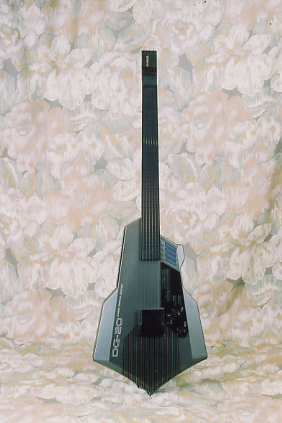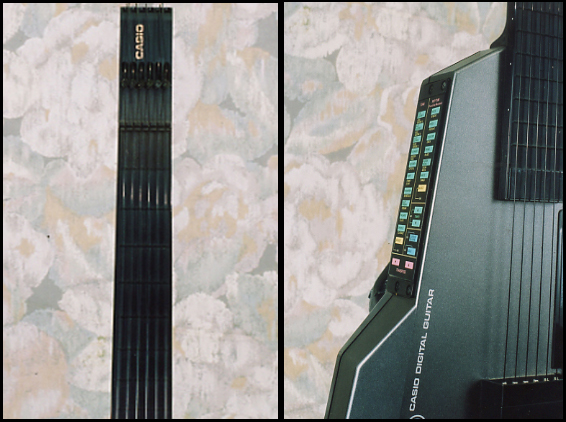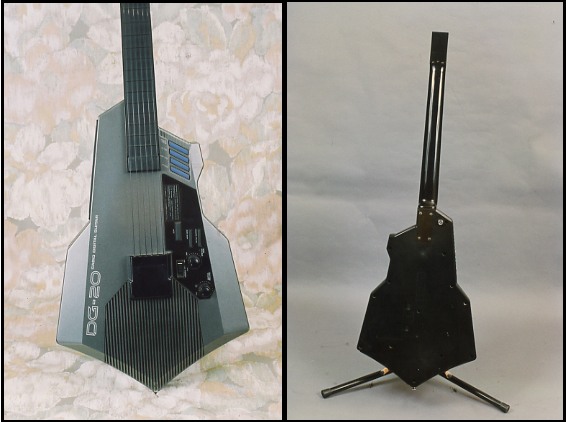By Michael Wright
The Different Strummer
Blame it on disco. I remember it well…as an observer, of course! The excesses of early ‘70s hard rock inspired a vapid dance craze reaction toward the end of the decade with mirror balls and platform shoes and, well, you know, Studio 54, glitter spandex, and Donna Summer and all that. The music was mostly played with keyboard synths and drum machines, fairly new technology at the time. The guitar press predicted: It’s The End of guitars as we know it. But was it really? (Obviously, we all know the answer to that rhetorical question!)
I didn’t really pay much personal attention to disco. I didn’t dance and I didn’t hear too many guitar solos to make me interested in listening. I was working at a commercial classical radio station at the time and my greatest exposure was a somewhat satirical—and as it turned out quite successful, I might add—disco party for key advertisers, for which I had to obtain the music. I was mildly alarmed by the press predictions regarding the demise of guitars, but I needn’t have worried.
Anyhow, the response of the guitar industry was to try to turn guitars into synth controllers. Keyboards are ideal synth controllers. They are immediate and precise. You hit a key and you get a clear electronic connection that is instantly, easily, and unequivocally recognized by the machine and its software. They’re perfectly polyphonic. And once you eliminate the need for anything but the keyboard—no strings, no soundboard, no pipes—they can become quite compact and portable.
Guitars…well, not so much. A good clean note is obtained with good clean contact between the string and the fret, but you know how often that doesn’t happen! We bend notes, even when we don’t intend to. We move our fingers around to put “English” on the tones. In short, despite the best efforts of brilliant engineers at Roland, Korg, Yamaha and elsewhere, guitars make lousy synth controllers at best. To play guitar synth you’d best possess pretty darned good technique.
Don’t get me wrong. I really admire the synth guitars that were created during the period from roughly 1977 to 1987 or so. But if you want to play some disco, get a keyboard.
That said, there were some interesting attempts to create a hybrid solution, notably by Casio, like this nifty little 1987 DG-10 Digital Guitar. Okay, I hear you sniggering about this toy guitar. You might say it doesn’t even look much like a guitar, although, if you recall guitars from the 1980s, you remember there was some weird stuff that was popular, from minimalist headless Steinbergers and Kramer Dukes to Prince’s elaborate guitar sculptures. All right, I’ll give you that it looks more like a toy than a guitar.
But let’s not focus on what it isn’t, let’s concentrate on what it actually is. This juicy little “toy” is actually a full-blown amp-in-guitar and MIDI controller. The fingerboard is a rubber touch pad with, presumably, articulated “frets” with 6 contact points each. The nylon strings are all like 3rd strings. Yamaha did this same thing on its synth controller, by the way. I suspect that’s to equalize the contact using identical string mass. There’s a built-in battery-powered amp with 4” speaker.
You can play this like a guitar, or guitars. On top you can choose from 20 preset sounds. You can add automatic percussion rhythms. Pick the tempo. Punch in sustain and reverb, and change the key. On the front you have an on/off switch, master volume and rhythm volume. You can mute your guitar, activate or turn off the rhythm sounds, add in some fill. Oh yes, and there’s a manual drum machine pad if you’re dexterous, with a choice of cymbals, low tom, hi tom, and snare drum sounds.

And if that’s not enough, you can send the signal out to an external amp. You can plug in headphones. Pick two MIDI modes, omni or poly, to coordinate with whatever gear you use. Plug in a MIDI DIN cable. And use an AC plug, should you be so inclined.
Yeah, any kid can figure this toy out. Well, maybe a kid could. I never got past the amp in guitar with automated drum machine and I hope my life never depends on knowing the difference between omni and poly synths. Not that I mastered even just playing guitar. I think I played at a couple of my son’s baseball games, sitting in the bleachers doing “charge” sounds. But the Casio DG-20, in the right hands, might just be the guitar you need to do disco!
For the record, as it were, I did continue to peruse disco record bins for a few years—disco was LP music, before CDs—and found, to my great surprise and delight, that there actually were some disco disks that featured hot guitar licks! Metal guitar disco. Numerous disco-flamenco fusions. Rasgueado goes great with the turn-around pump of “unh-uhh, unh-uhh, unh-uhh.” They were never too popular, though. Blame it on disco.


Looking at it through contemporary eyes, it looks like a “stealth” guitar!
Thanks for covering the DG20! I’ve been on a quest for one for a while and finally managed to snag one in 2015, for a decent price. As odd as they seem, you can do some cool things with them and running the DG20 sounds through effects really adds depth to them. From Flight of the Conchords rhythm beats to an OK-sounding Hammond organ patch, it can really shine, in the right situation.
The Flight of the Conchords not only use, but name check the Casio DG-20 Electric Guitar in one of their songs…..set to mandolin.
I had one of these Casio DG-20 synths (briefly) in the late ’80s; first of all, I hate to be the bearer of bad news, but by 1987 the “Disco Age” was wa-ay over. That moment could possibly be ascribed to the mid-to-late 1970s, and while discos still had big business into the 1980s, that “era” was pretty much over. The 1980s was characterized with a return to BIG rock, with bands such as Van Halen, AC/DC, Ozzy, Aerosmith, Def Leppard, Iron Maiden, Guns ‘n’ Roses, Poison and various other huge “hair bands” dominated the FM airwaves, and the early Rap stars such as Run DMC and LL Cool J were developing that genre. Synths were far from being identified with “Disco” by 1987, as the adventurous sound explorations of Peter Gabriel and Frank Zappa using the Fairlight and Synclavier respectively attest to. In fact, Roland’s guitar synths were already well-placed in the musician’s market, as such decidedly non-Disco guitarists such as John McLaughlin and Pat Metheny used various synth controllers for guitars (see https://www.youtube.com/watch?v=vr78ISrTElE).
Now, back to the Casio attempt: It fairly sucked – not by virtue of it’s sounds, which were pretty usable, but the triggering and latency, along with the quite alien feel of the rubberized “strings” made the rather cool-looking (admit it – is seems to be based on Darth Vader’s helmet!) rather useless as a usable stage or recording instrument. Nothing to do with Disco in 1987, though…
I had one of these things. It was a toy. No more, no less. A real dissipointment. It finally broke, I trashed it.
Hi i am looking for a casio dg 20 guitar . do you have once for sale? Thanks
Wow. Until I came across this article I had not thought about this Casio “guitar” for years. I remember it was available in the toy section of Emporium — a now defunct CA department store chain. There was one available for demo at the end of an aisle. I had just recently started playing real guitar and recall how rubbery and fake the strings were and how it took a while for the sound to register after striking the strings. Does anyone recall how much it cost new?
I have one for sale.
simon cooper want to sell me?
I have a DG-20 for sale. Contact me: 3rdstone@comcast.net
I bought one for 35€… Yesterday. I got the dg1 in Christmas and i fell in love with it.
I have the dg- 20 for sale also but don’t know how much thay go for anyone interested? ?
I have a dg 20 for sale if you are interested for £200
I have one of these that a keyboard playing friend got from another friend. It’s a fun toy but really not any better at triggering a synth than my Roland GR synths. Coordination between the picking hand and fretting hand seems to be the key in both. Also I notice when I use the internal sounds they can sustain for as long as you hold the note down but when controlling a midi synth they only sustain for a couple seconds.
So it doesn’t sustain midi notes with external synth/samplers when holding down the frets?
If you put it onto the organ mode whilst plugged into midi, then the notes sustain.
I’ve wanted one of the old Casio guitars for a while now. I love the style — it would complement my fretless Steinberger bass well.
I have a Casio dg-20 for sale if a y ody is looken for 1
Hey I’m looking for a DG-20 as well. Please contact me at polydiatonic@verizon.net if you’ve got one that you’re not attached to. Thanks!
Hi, I have dg-20 for sale ali.caspian70@gmail.com
Hi, I have dg-20 for sale
Hi i am interested in a DG-20, please contact me at zlatangub123@gmail.com
Hello everyone! I’m looking for a DG-20 or DG-10 as well. Please email me at albert.whatever@gmail.com if you’re willing to part with one. Thanks!
HI ALL…I’m looking for the Casio DG 20 strings with its complete assembly..if anyone has for sale..thanks
I have one for sale. Like new, stored in a closet for years. Part of an estate sale.
Lawrence Jewett I’m interested in buying one. Can you send me more details on fernandesguitarra02@gmail.com
Looking to pick up a working dg-20! Pleaae send details to adamsatoms@outlook.com
Defiantly just recently fell in love with this thing over the past few days I know it’s being compared to a toy but I’ve seen some people do some crazy shit with these and would love to find one myself I know there not insanely popular and that’s why there hard to get ahold of tho
我很想要一把DG-20,从我知道这把琴开始我就疯狂的寻找,我感觉人生中如果少这么一把琴,该多么遗憾,希望你会以合适的价格卖给我